Poster Day 2014
Emma Agnew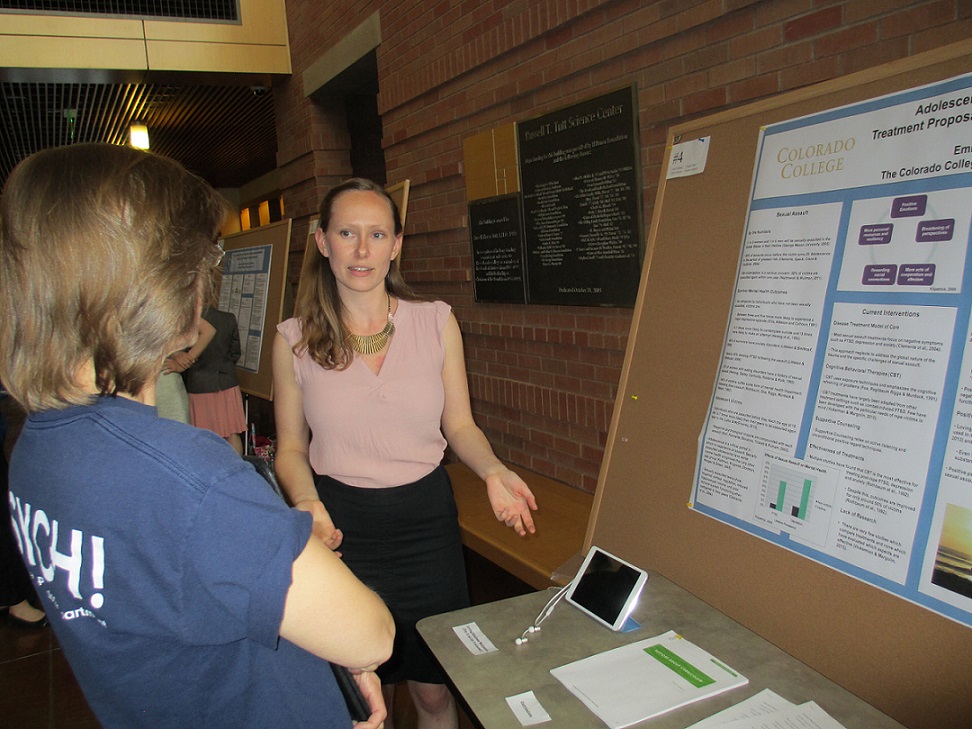
Psychology
Advisor: Tomi-Ann Roberts
Adolescent Sexual Assault: Treatment Proposal and a Call for Research
The sexual assault of adolescents has serious mental health consequences including depression, anxiety, mental illness, and suicide. It also often results in behavioral problems and physical health impairments. There are a variety of treatments currently available, but they have failed to reliably help the majority of victims. This problem is compounded by a lack of comprehensive and rigorous research. This paper will firstly propose that interventions be reshaped to incorporate more positive psychology techniques. Positive emotions have been demonstrated to build personal resources and resiliency, and are effectively used with other similar traumas. Additionally, this paper will make the case that more research on sexual assault needs to be conducted. Basic matters such as definition and scope of the problem are not well understood. This decreases the likelihood of successfully helping sexual assault victims.
Yiqiao Bao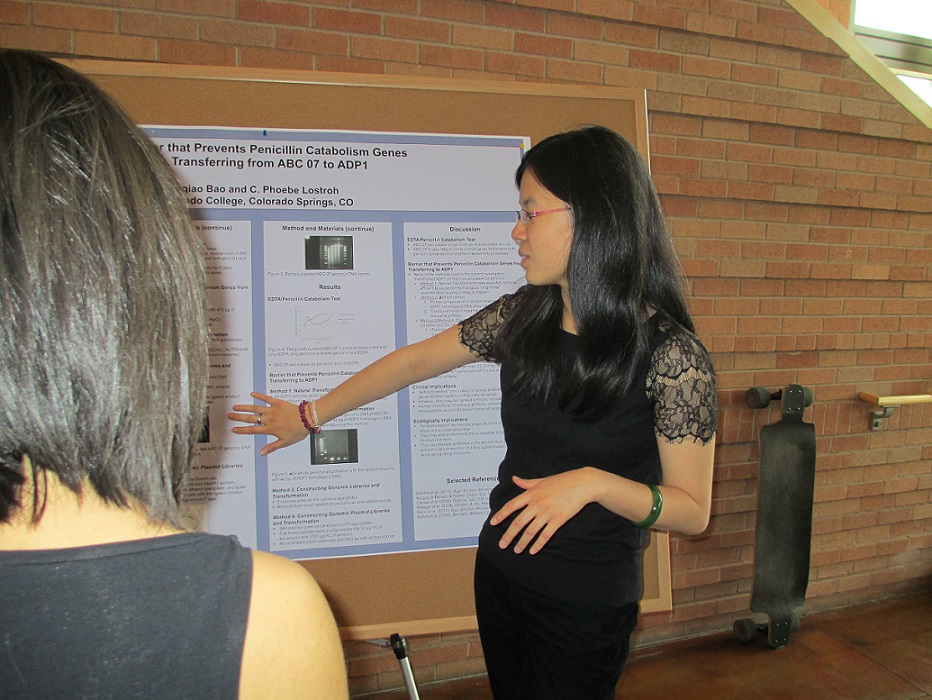
Neuroscience
Advisor: C. Phoebe Lostroh
The Barrier that Prevents Penicillin Catabolism Genes from Transferring from ABC 07 to ADP1
There are hundreds of phylogenetically diverse soil bacteria with the capacity to grow on a wide range of antibiotics as their sole carbon source. Some of these bacteria are closely related to human pathogens. The present study evaluates whether there is a barrier that might prevent the penicillin catabolism genes from transferring from the penicillin catabolism strain ABC 07 to the Acinetobacter baylyi strain ADP1. Because of its natural competence and its close relation to the human pathogen Acinetobacter baumanni, ADP1 is an ideal model for the current investigation. ADP1 was transformed with the genomic DNA of ABC 07, Sau3A1 genomic libraries, and Sau3A1 genomic plasmid libraries to test this barrier. None of these methods transformed ADP1 to be a strain with a penicillin catabolism phenotype. In this regard, recent research (Walsh et al., 2013) challenges the concept of bacteria subsisting on antibiotics and argues that the SCS selective medium used in the original study (Dantas et al, 2008) contains 15 mg/L EDTA, which could be the carbon source that sustained the growth of these "antibiotic-eaters." The present study also tested and verified that ABC 07 can subsist on penicillin, but not EDTA. These results suggest that antibiotic catabolism genes cannot be readily transferred from antibiotic catabolism strains to other bacteria. Future research related to antibiotic catabolism phenotype should attempt computational approaches and system-level molecular methods to identify antibiotic catabolism genes and metabolic pathways before further characterizing their clinical and ecological implications.
Ellen Beckett
Neuroscience
Advisor: Lori Driscoll
The Effect of the Polybrominated Diphenyl Ether Mixture DE-71 on Hedonic Reinforcement and Incentive Salience in Rats
Polybrominated diphenyl ethers (PBDEs) are persistent organic pollutants that were once widely used as flame retardants. PBDEs are liberated from plastics into the environment and enter the food chain, leading to human exposure through the consumption of contaminated meat and dairy products. Within the body, PBDEs have been shown to bioaccumulate and are thus passed from mother to child through the placenta during gestation and postnatally via breast milk. The present study investigated the effect of early postnatal exposure to the PBDE commercial mixture DE-71 on behavioral motivation. Motivation is comprised of two essential mechanisms: hedonic reinforcement (liking) and incentive salience (wanting). A sucrose preference test was conducted to determine if DE-71 exposure decreased hedonic reinforcement and a progressive ratio task was used to determine if incentive salience was affected. It was found that DE-71 exposure produced a significant increase in sucrose preference. This increase in hedonic tone was not ameliorated when exposed rats were given "rescue" doses of thyroid hormones to reverse the hypothyroidism induced by DE-71. There were no significant differences between treatment groups and controls on the progressive ratio task, although there was a significant sexual dimorphism of lever pressing in the high dose (60 mg/kg DE-71) group. Increased sucrose preference is most likely the result of PBDE-mediated disruption of the GABA system; further investigation is recommended to test this hypothesis.
Morgan Bessette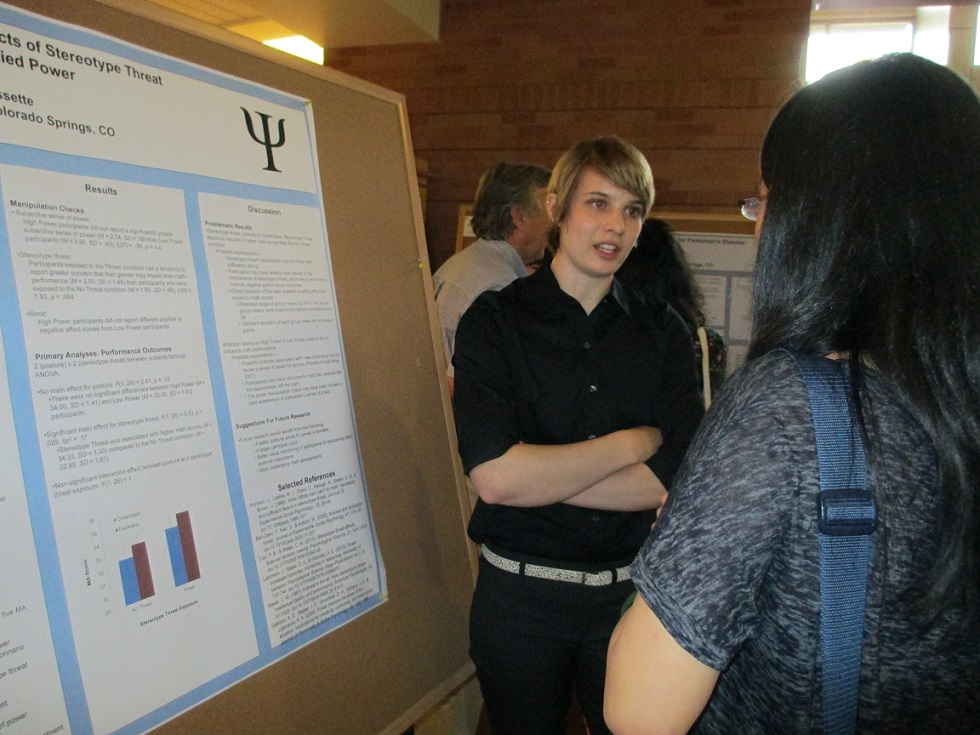
Psychology
Advisor: Tricia Waters
Mitigating the Deleterious Effects of Stereotype Threat through Embodied Power
Recent research (Van Loo & Rydell, 2013) has demonstrated that priming women with power words reduces the negative effects that stereotype threat has on their math performance. The present research explored whether priming women with an expansive high-power posture, as opposed to a constricted low-power posture, prior to stereotype threat exposure, would mitigate the deleterious effects that stereotype threat has on their math performance. Results indicated that in comparison to the low power prime, the high power prime did not lead to better math performance outcomes regardless of stereotype threat exposure. Although the present work did not find support for the experimental hypothesis, several reasons as to why this occurred are presented in the discussion, including a critique, and suggestions for further research regarding embodied power priming.
Elena Biagioni
Psychology
Advisor: Tricia Waters
Autism and Emotions
This paper investigates recognition and understanding of non-verbal expressions of emotions by individuals with autism spectrum disorder compared to typically developing individuals. Individuals with autism spectrum disorder seem to share similar attention to the informative regions of a face with typically developing individuals, but engage in different processing approaches, and have somewhat different neurology. Individuals with autism spectrum disorder show deficits in the recognition of basic emotions and complex mental states, perhaps with happy being an exception. However, some studies have found that individuals with autism spectrum disorder are as able to accurately recognize emotions similarly to typically developing individuals, suggesting further research is required to flesh out their true abilities and deficits. The gender of the individual with autism spectrum disorder, and of the actor in the stimuli used, should be taken into account, as should the angle of the face in the stimuli, and the influence of culture on our comprehension of autism spectrum disorder individuals and their emotional deficits.
Julia E. Boese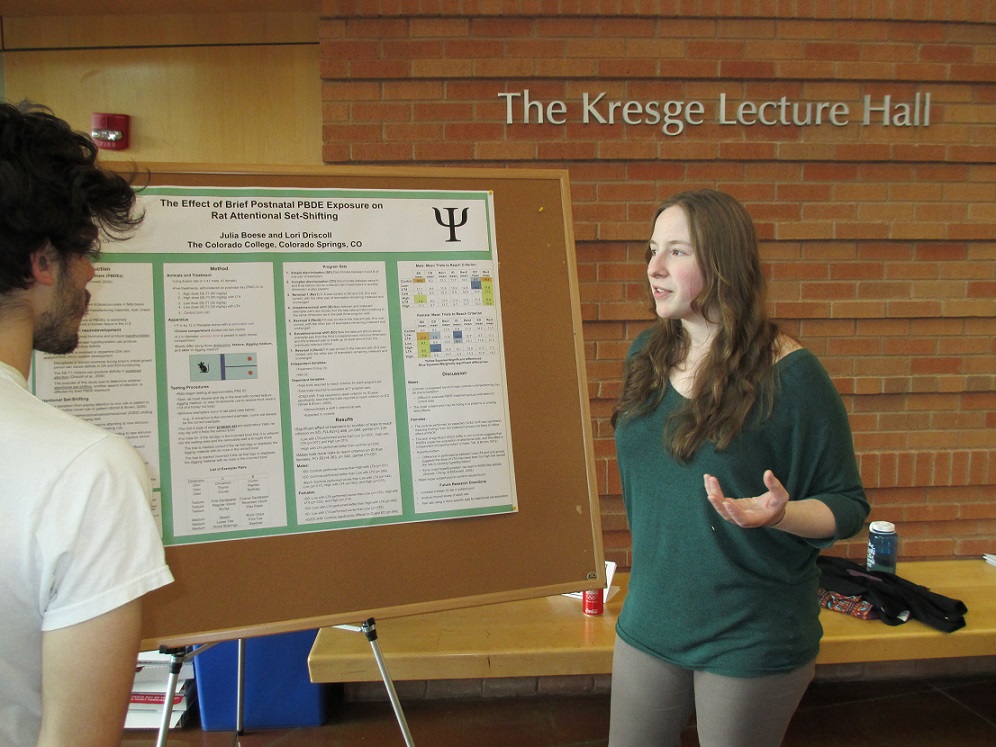
Neuroscience
Advisor: Lori Driscoll
The Effect of Brief Postnatal PBDE Exposure on Rat Attentional Set-Shifting
Polybrominated diphenyl ethers (PBDEs) are flame retardants, used in plastics, that may impact human health through their environmental ubiquity and bioaccumulative properties. DE-71, a commercial mixture of PBDEs, worsens sustained attention in rats, which prompted this study to investigate whether brief postnatal exposure to DE-71 impairs rats' attentional set shifting (AS) abilities. AS is the cognitive transition from paying attention to one rule or pattern to focusing on a novel rule or pattern. Forty-one male and 41 female rats were divided into three DE-71 exposure groups: high dose (60 mg/kg), low dose (30 mg/kg), and control (corn oil). To determine if any impairments in AS were due to DE-71's suppression of thyroid hormone homeostasis, half of the exposed rats were given 6 µg/kg of synthetic thyroid hormone (LT4). DE-71 and LT4 were administered daily on postnatal days (PND) 6-12 and the sand digging task began on PND 65. The female controls were the only group to demonstrate the expected attentional set shift, indicating that exposure to DE-71 interferes with either attentional set acquisition or shifting in females. Male data were equivocal, perhaps due to the young age at which the animals were tested.
Katherine Duker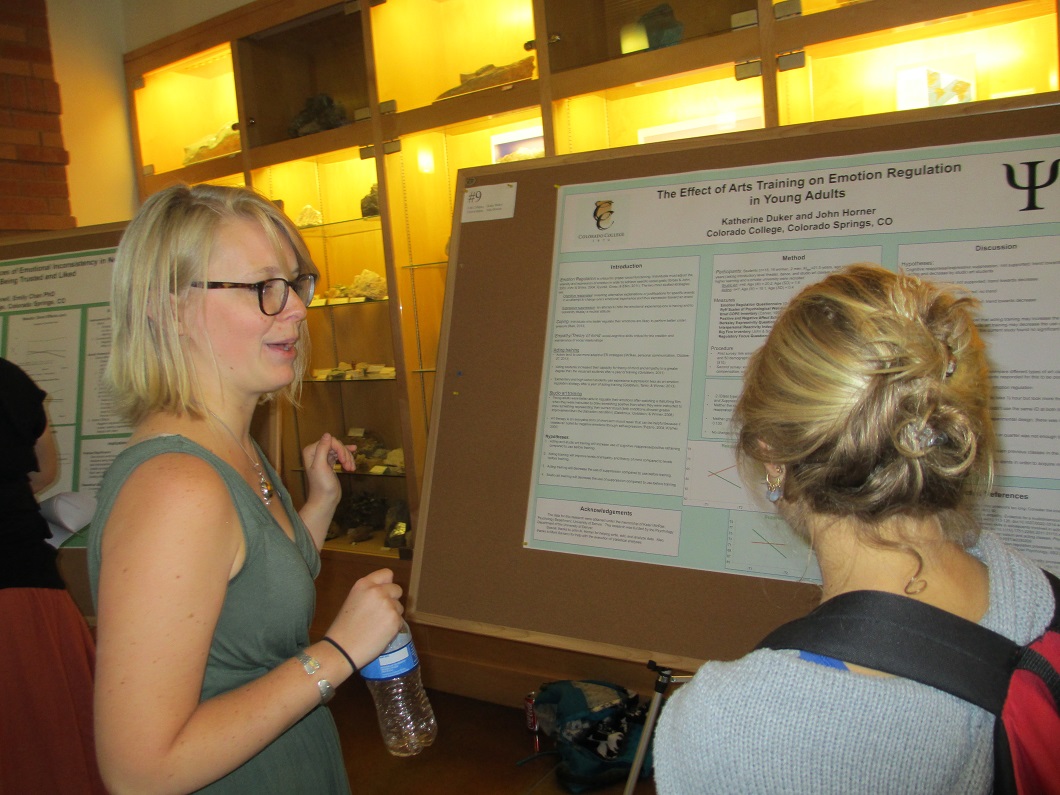
Neuroscience
Advisor: John Horner
The Effect of Arts Training on Emotion Regulation
McRae (personal communication, October 27, 2013) observed that individuals who identify as artists tend to be better at regulating emotions than non-artists. Previous studies have found that both acting training and creating art have been shown to have a positive effect on emotion regulation in a developmental context. The present study investigates whether studio art or acting training affect the use of emotional regulation strategies, such as cognitive reappraisal and expressive suppression. Using a quasi-experimental, longitudinal design, participants' emotion regulation strategies were analyzed before and after taking an introductory level art class at a private and a public university. Emotion regulation strategies were identified using 8 scales. There were no statistically significant findings. This lack of results may be due to the low number of participants (n=13), but trends were identified within the data that are somewhat consistent with past research. Studio art students tended to decrease their use of both adaptive and maladaptive regulation strategies, such as cognitive reappraisal and expressive suppression (respectively), while acting students tended to increase their use of adaptive strategies, such as cognitive reappraisal.
Mari Gades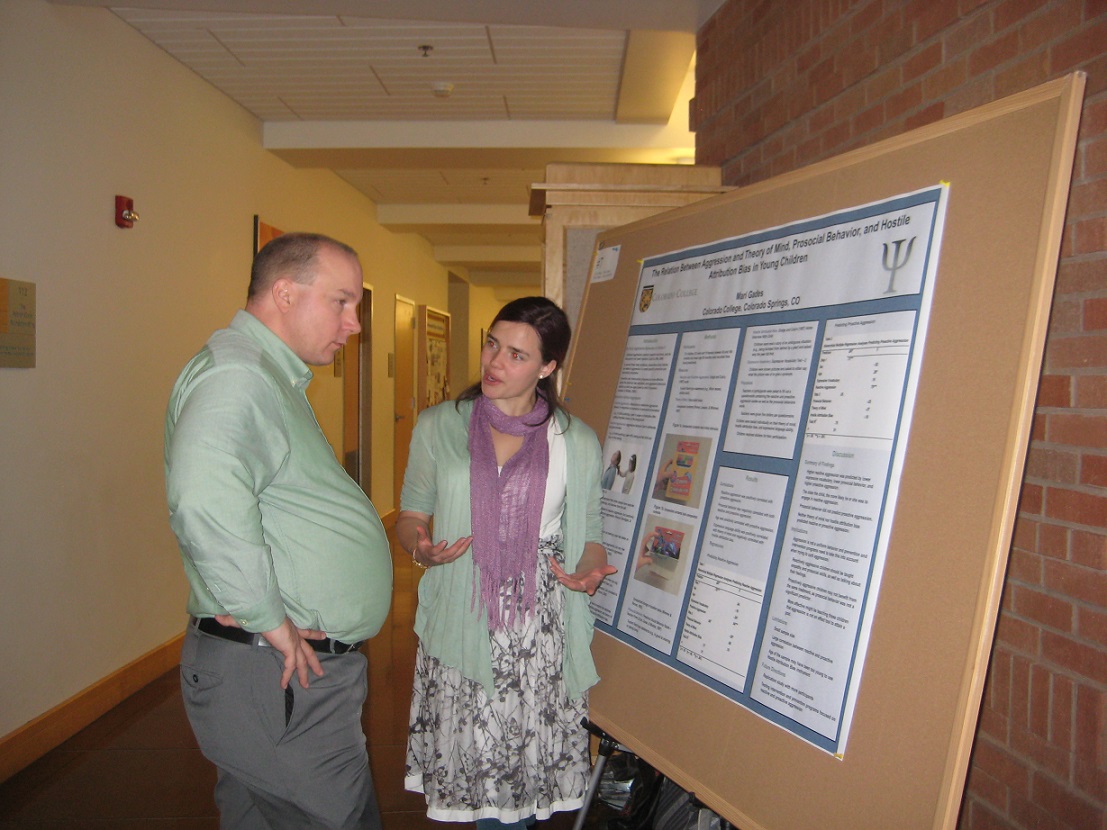
Psychology
Advisor: Tricia Waters
The Relation between Aggression Subtypes and Theory of Mind, Prosocial Behavior, and Hostile Attribution Bias in Young Children
Bullying and aggression in childhood can lead to many social and emotional problems for both the instigator of aggression and the victim. To stop aggression before it can create these problems, it is important to create prevention and intervention programs for children exhibiting behaviors that may predict aggression. In this study we examined theory of mind, prosocial behavior, and hostile attribution bias as possible predictors for proactive and reactive aggression in young children. Results suggest that reactive aggression and age, but none of the target variables, significantly and positively predict proactive aggression. Proactive aggression negative and expressive vocabulary positively predicted reactive aggression. Prosocial behavior significantly predicted reactive aggression, but did not significantly predict proactive aggression. Contrary to expectations, neither theory of mind nor hostile attribution bias was related to reactive or proactive aggression. Implications for findings are discussed.
Arianna Gentile Polese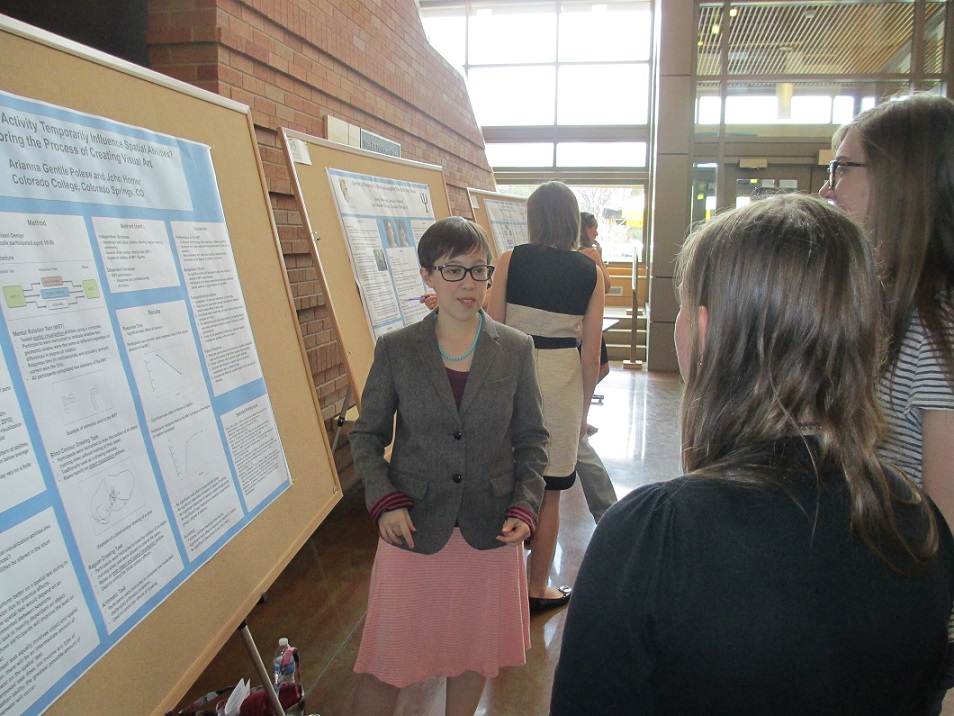
Neuroscience
Advisor: John Horner
Can a Drawing Activity Temporarily Influence Spatial Abilities? Exploring the Process of Creating Visual Art
Observational drawing (drawing realistically from life) is an essential skill for some visual artists, and the process is difficult to master due to perceptual bias. Previous research has suggested that professional visual artists employ perceptual strategies acquired through experience in order to overcome perceptual biases. There is evidence that acquiring these perceptual strategies may interfere with the development of spatial perceptual processes such as mental rotation ability. The present study's purpose was to determine whether impairment of spatial abilities could be induced in the short term by having participants (N = 50) perform a blind contour drawing, regular drawing, or arithmetic task before retesting their spatial abilities. The results did not show any significant effect of the type of task on spatial abilities performance; however this finding is still informative in the context of visual perception research as it relates to drawing.
Sheridan Gribbon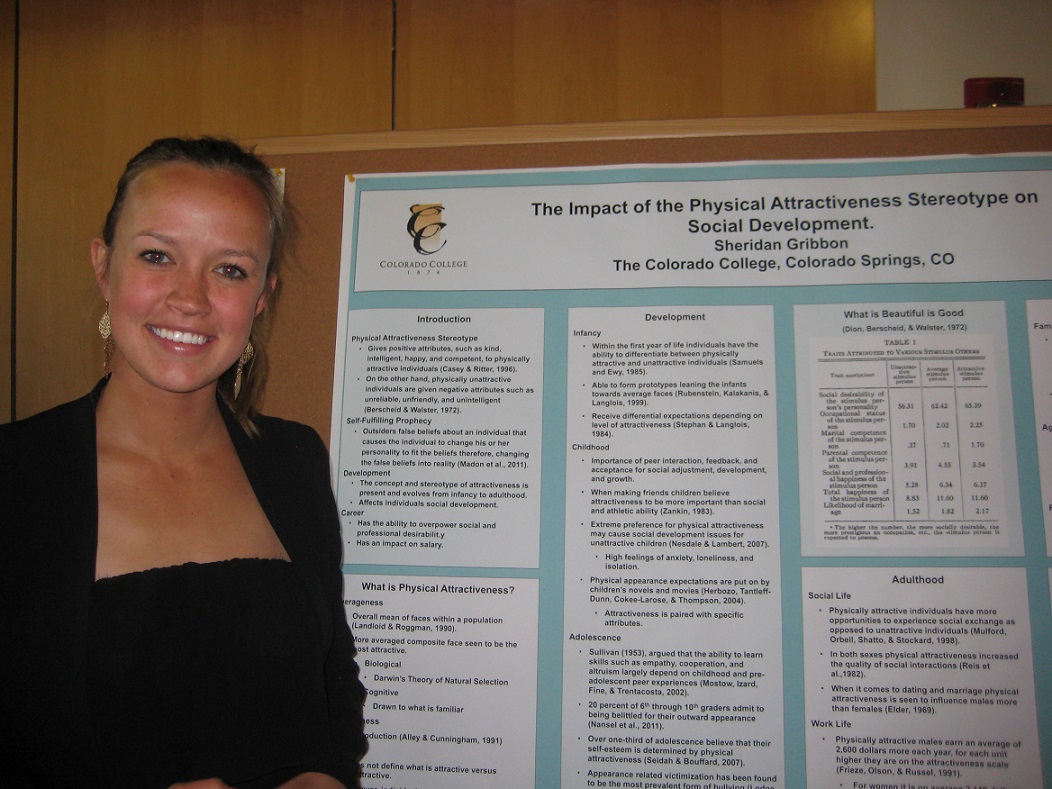
Psychology
Advisor: Emily Chan
The Effect of the Physical Attractiveness Stereotype on Social Development
The physical attractive stereotype gives positive attributions to physically attractive individuals while questioning the competence of their unattractive counterparts. From as early as infancy, individuals are able to recognize the concept of attractiveness and create false characteristics about individuals depending on their physical appearance. From infancy to adolescence social challenges are showered upon individuals who are viewed as unattractive, which in turn can negatively influence the individuals social development. This concept continues into adulthood through impacting individuals' social and occupational opportunities and experiences. However, through familiarity, age, gender, and awareness individuals have the option to challenge the physical attractiveness stereotype and overcome outsider's false perceptions.
Rob Kerr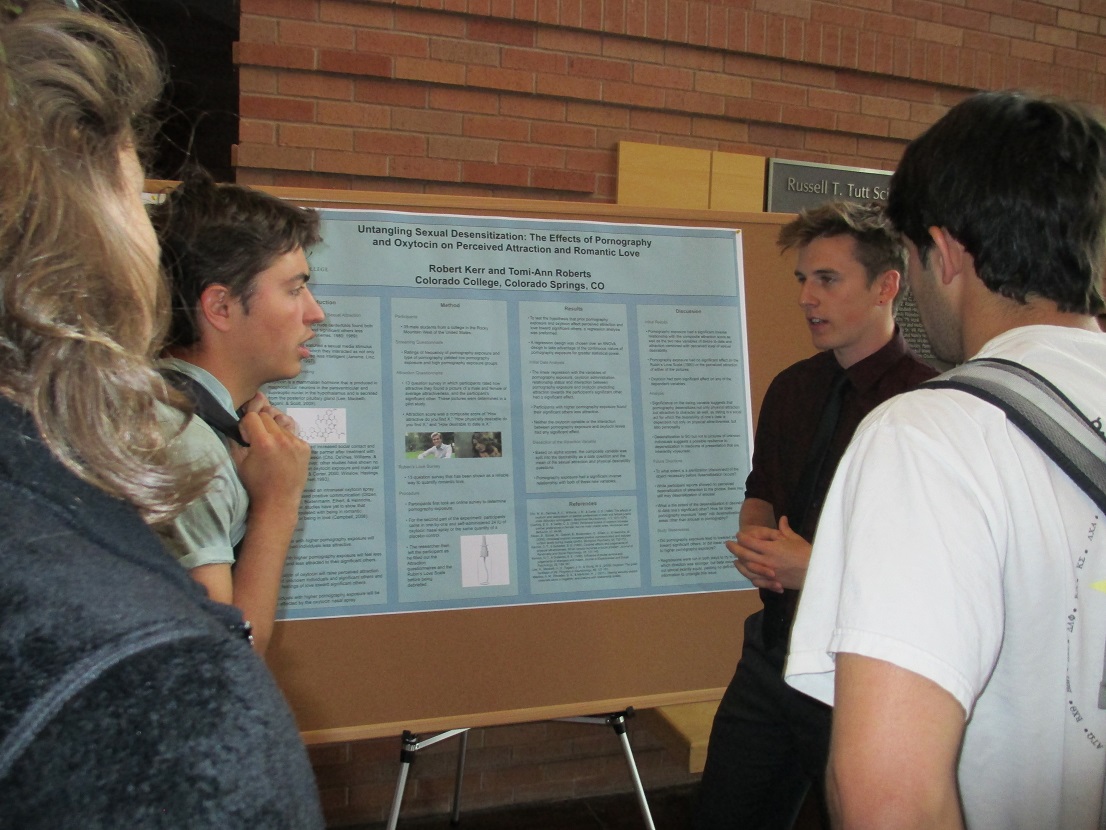
Psychology
Advisor: Tomi-Ann Roberts
Untangling Sexual Desensitization: The Effects of Pornography and Oxytocin on Perceived attraction and Romantic Love
This study explored the effects of pornography exposure and oxytocin on perceptions of the attractiveness of strangers, and perceptions of attraction and feelings of romantic love for significant others, in male college students. This research is an imperative update on work on pornography exposure in the 1980s given the ubiquity and accessibility of internet pornography. Results suggested that individuals with higher pornography exposure found their significant others less physically attractive and less desirable to date than individuals with lower pornography exposure. Oxytocin did not mediate this effect, though this may have been due to a small sample size. This outcome has strong implications for how sexual and voyeuristic mediums influence both desensitization of attraction and desensitization of perceived character toward significant others. Further research is required to determine the extent of this desensitization of perceived character and if it applies to individuals other than one's significant other.
Megan Masuret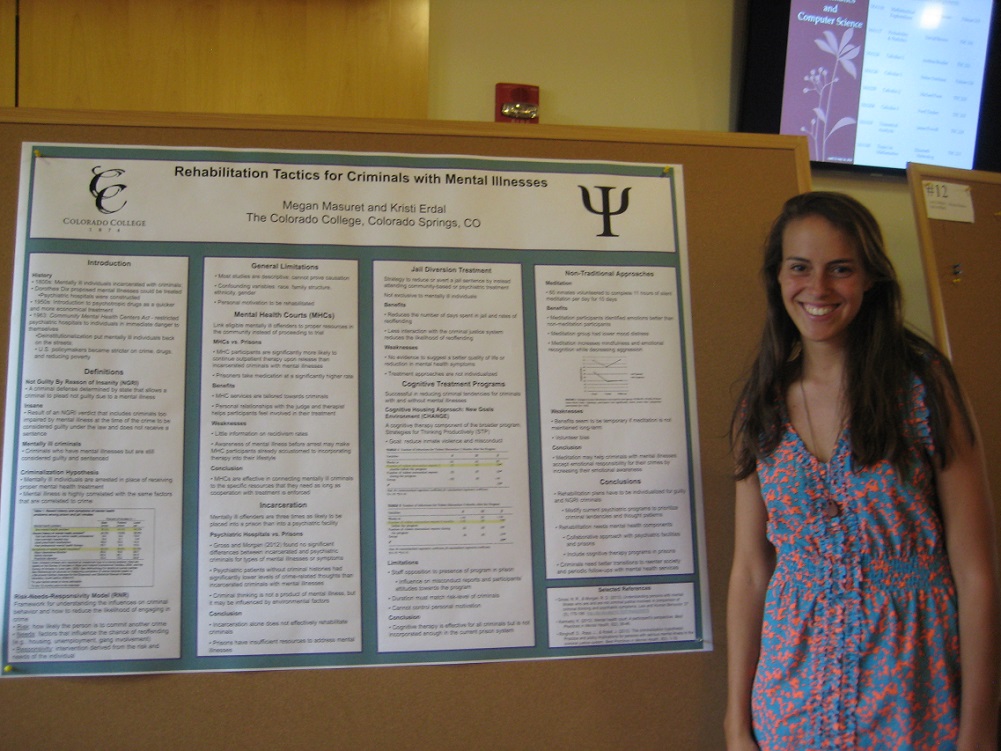
Psychology
Advisor: Kristi Erdal
Rehabilitation Tactics for Criminals with Mental Illness
Individuals with mental illnesses are arrested and incarcerated at higher rates but are not always provided the necessary resources to overcome their illness and their criminal thinking. Although some states recognize that some individuals are not guilty by reason of insanity, the current incarceration system does not effectively rehabilitate criminals with mental illnesses. By studying the way in which the mentally ill and criminals are independently rehabilitated, it is possible to extract the tactics that would most effectively contribute to an improved system of rehabilitation. The most important aspects of rehabilitation that are neglected in the incarcerated population are individualized treatment plans and access to cognitive therapy. By properly transforming offenders rather than punishing them, it is possible to lower both recidivism rates and the dangerousness of an offender to society.
Claire McNellan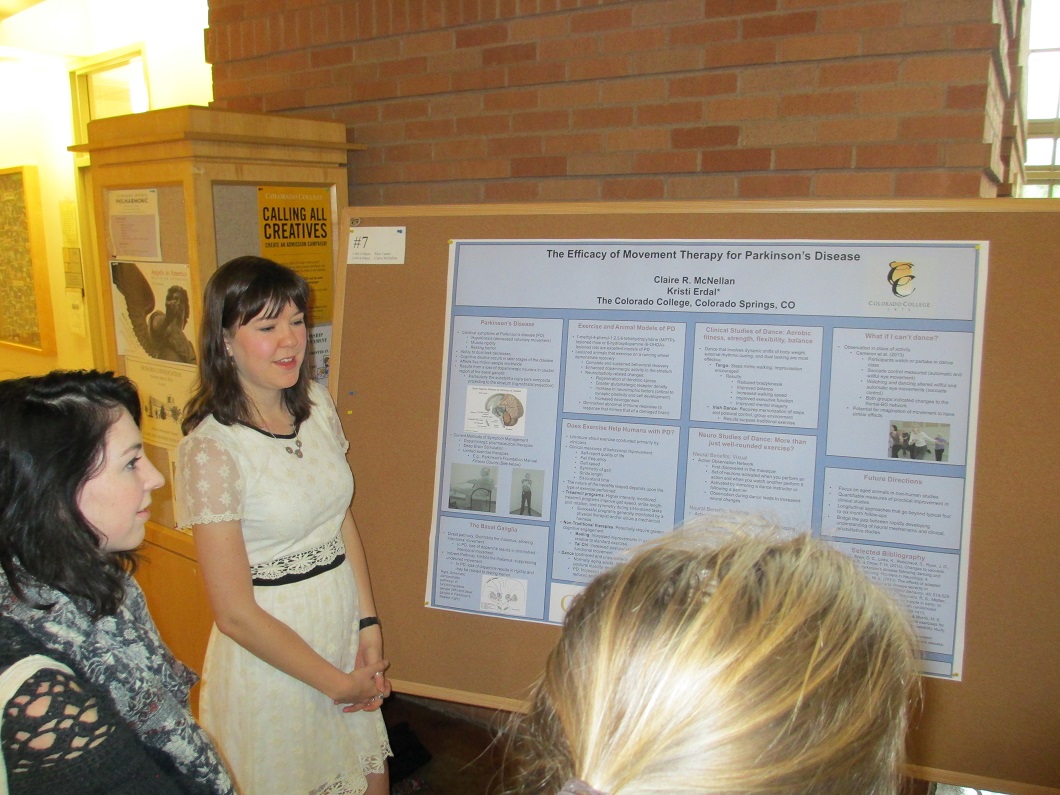
Neuroscience
Advisor: Kristi Erdal
The Efficacy of Movement Therapy for Parkinson's Disease
Motor symptoms of Parkinson's disease are currently managed by pharmaceutical approaches and neurosurgery. This review examines the efficacy of movement therapy in enhancing or replacing standard treatment methods. Movement therapy has the potential to alleviate parkinsonian deficits without side effects or invasive measures. A growing body of literature about mice and rat models of Parkinson's disease suggests that running on a treadmill results in increased dopaminergic activity, beneficial structural changes, and diminished abnormal immune response in the brain. Similar changes are reflected in research about exercise programs for humans with Parkinson's disease, including treadmill, Tai Chi, and, most promisingly, dance. The success of dance therapy may be due to activation of the Action Observation Network (AON) when a dancer mirrors an instructor, external rhythmic cueing, and increased cognitive engagement. Future investigation of the length and type of dance program that provides the greatest benefit is warranted, and researchers should continue to seek quantifiable measures of practical motor improvements. Research should additionally explore the possibility that observation and imagination of movement might be effective in alleviating motor deficits.
S. Casey O'Donnell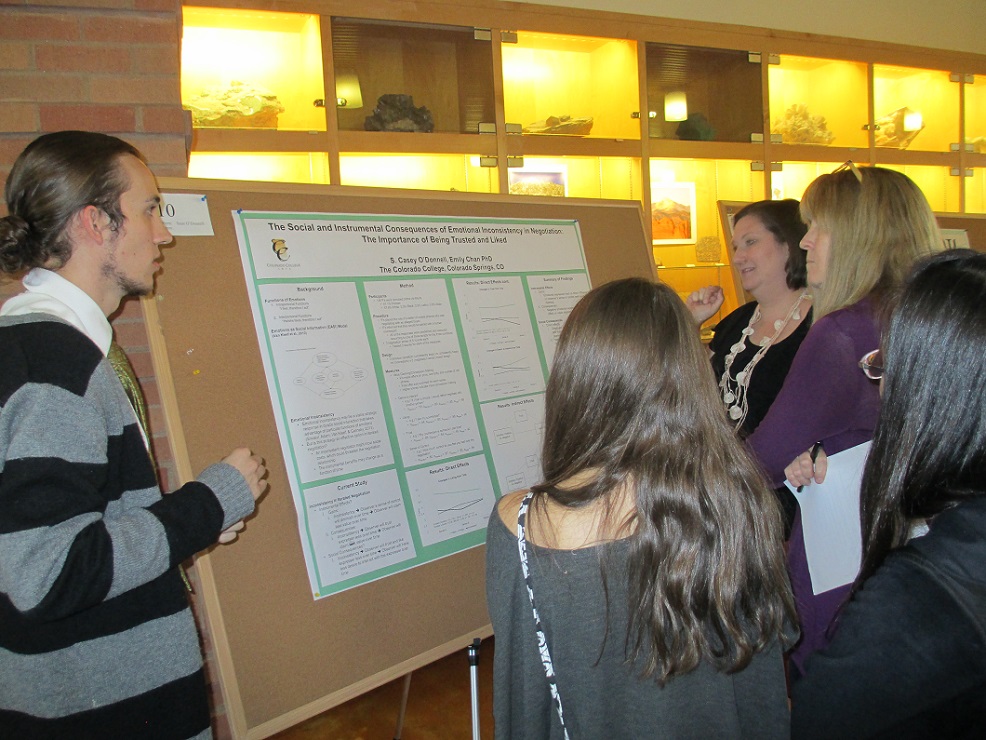
Psychology
Advisor: Emily Chan
The Social and Instrumental Costs of Emotional Inconsistency: The Importance of Being Trusted and Liked
In single transaction negotiation, being emotionally inconsistent appears to be an effective strategy for extracting greater concessions by undermining the opponent's sense of control (Sinceur, Adam, Van Kleef, & Galinsky, 2013). However, the consequences of emotional inconsistency in iterative negotiation have not been examined. To explore the instrumental and social consequences of emotional inconsistency, participants (N = 146) negotiated against a computer-simulated opponent whose responses were consistently happy, consistently angry, or emotionally inconsistent over multiple negotiation trials. In general, angry and inconsistent negotiators were less trusted and had worse instrumental outcomes. What is more, these Machiavellian-style strategies risked severing the negotiation relationship. Angry and inconsistent opponents were less liked and less trusted, making them less desirable negotiation partners as compared to happy opponents. The implications of these findings are discussed using the Emotions as Social Information Model.
Shaina Riciputi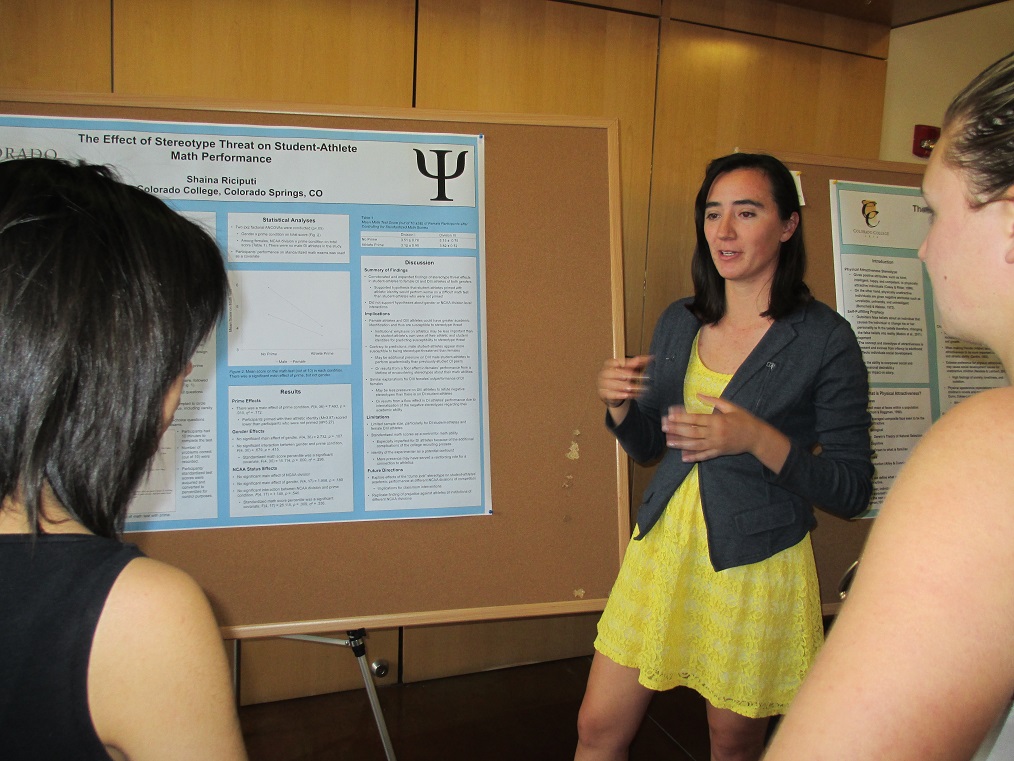
Psychology
Advisor: Kristi Erdal
The Effect of Stereotype Threat on Student-Athlete Math Performance
The current study expanded on previous research showing stereotype threat-related decrements in the academic performance of student-athletes by measuring their performance on a difficult math test after either being primed with their athletic identity or not. The primary hypothesis was that athletically-primed student-athletes would perform more poorly than unprimed student-athletes. Males and females were also anticipated to be differentially affected by the prime, with females performing more poorly than males when primed. Furthermore, Division I and Division III athletes were expected to be differentially affected by the prime, with Division I athletes performing worse following priming than Division III athletes. The results of the study supported the hypothesis about the overall effects of the prime. This experiment provides the first evidence for stereotype threat effects in Division III athletes of both genders and female Division I student-athletes. These findings add to a growing picture of the effects of student-athlete stereotyping on the academic success of student-athletes across a spectrum of collegiate environments, with important implications.
Jake Russin
Neuroscience
Advisor: Kristi Erdal
Reasoning in the Prefrontal Cortex: A Review of Three Subcomponents and Their Functions
This paper identifies three anatomic subcomponents of prefrontal cortex as major contributors to reasoning processes: the right lateral prefrontal cortex, the left lateral prefrontal cortex and frontopolar cortex. Findings from both reasoning and non-reasoning research are considered in order to define the specific aspect of cognition accomplished by each brain region. The right lateral prefrontal cortex contextualizes the problem at hand by inhibiting aspects of perceptual regularity or semantic content so that reasoning can occur more efficiently. The left lateral prefrontal cortex abstracts relational information and generates hypotheses within the context provided by the right lateral prefrontal cortex. Frontopolar cortex maintains multiple relations generated by the left lateral prefrontal cortex and allows for their integration. Alternative models of reasoning in the prefrontal cortex, including anatomic hierarchies and dual-process theory, are considered and suggestions for future research are provided.
Abigail J. Sawyer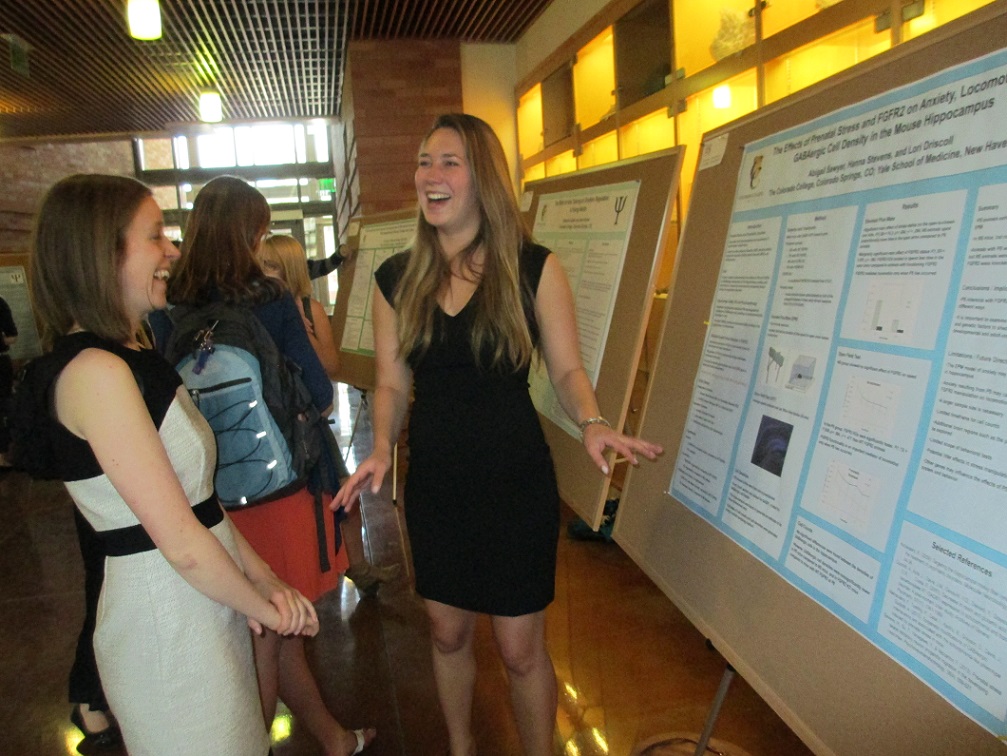
Neuroscience
Advisors: Lori Driscoll & Hanna Stevens
The Effects of Prenatal Stress and FGFR2 on Anxiety, Locomotion and GABAergic Cell Density in the Mouse Hippocampus
Prenatal stress (PS) influences aspects of neural development that subsequently bias neural systems toward the expression of developmental and adult psychiatric disorders. The γ-aminobuytric acid (GABA)ergic system, the main inhibitory neurotransmitter system in the brain, is impacted by PS, particularly in the hippocampus. Fibroblast growth factor receptor 2 (FGFR2), which contributes to a wide variety of functions throughout the lifespan, could be the mediator between PS and its effects on the GABAergic system. The current study explored this hypothesis by examining anxiety and locomotion in stressed (PS) and nonstressed (NS) mice with an intact or knocked out (KO) FGFR2 gene. PS animals were more anxious than NS animals, but NS animals were more impacted by the anxiogenic effect of the FGFR2 manipulation. In contrast, in the locomotion test, NS animals were unaffected by the FGFR2 manipulation, but PS animals were hyperactive when FGFR2 was absent. The GABAergic system seemed to be unaffected by these manipulations in the hippocampus. The current study shows some inconsistencies with past literature, and future work must be conducted to clarify the relationship between PS, FGFR2 and the GABAergic system.
Brittany Soto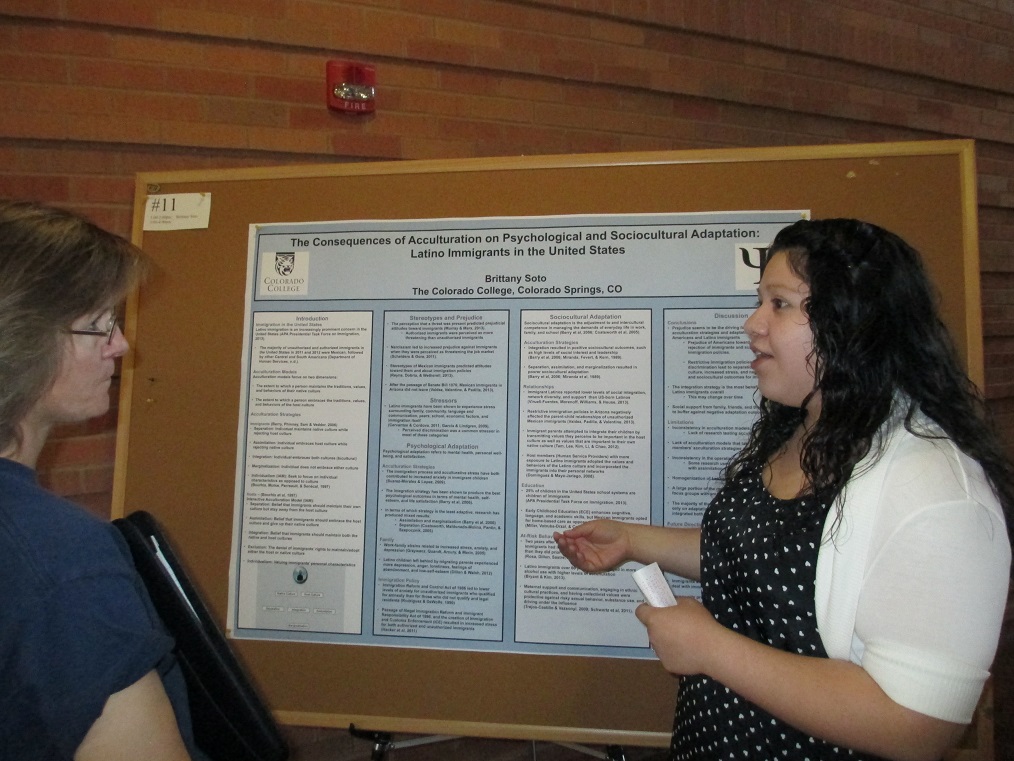
Psychology
Advisor: Emily Chan
The Consequences of Acculturation on Psychological and Sociocultural Adaptation: Latino Immigrants in the United States
Latino immigration is an increasingly important concern in the United States (APA Presidential Task Force on Immigration, 2013). This review examines current acculturation models as well as research regarding the sociocultural and psychological adaptation of Latino immigrants. Acculturation models are based on the extent to which individuals maintain their own culture and the extent to which they embrace another culture and acculturation is described as a two-sided experience, in which both cultures are affected. Major stressors for Latino immigrants are related to the immigration process, family, work, school, community, and economic factors, which can affect mental health, relationships, behavior, and education. Research suggests that integration is the best strategy for Latino immigrants. Limitations include present acculturation models and a lack of research specifically examining the relationship between acculturation strategies and outcomes. Future directions include community engagement, education, and comprehensive research methodologies.
Hillie Teller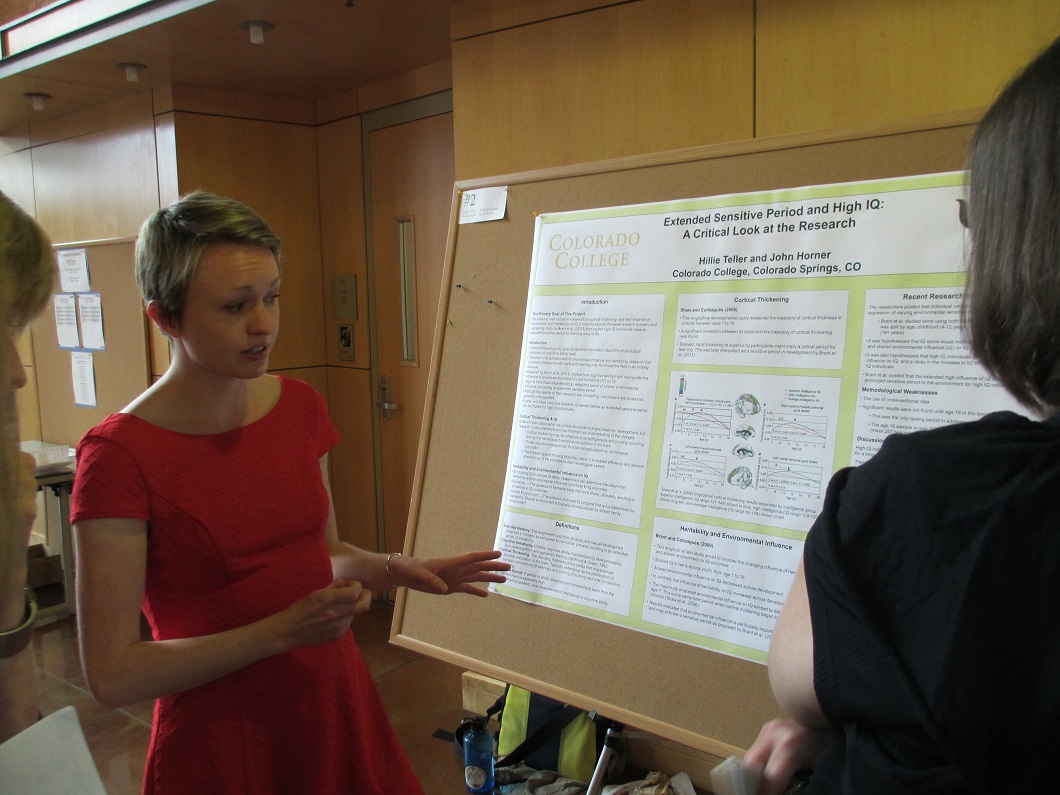
Psychology
Advisor: John Horner
Extended Sensitive Period and High IQ: A Critical Look at the Research
The extended neoteny and cognitive immaturity observed in human development may be adaptive and necessary for forming human cognition. Similarly, the study of cortical thickening may hold valuable information on the physiological indicators of ability level. If studied in conjunction with environmental influence and heritability, research that connects intelligence with cortical thickening may illuminate the field in an entirely new way. The development of human intelligence as measured by IQ has been studied in many parallel fields, but longitudinal research is limited in merging these areas. Recent research by Brant et al. (2013) aimed to uncover how cognitive ability might manipulate the influence of shared environment (c2) and heritability (h2) on IQ. The authors concluded that high IQ individuals experience an extended period of shared environmental influence, proposing an extended sensitive period. Although the results of their research are compelling, a critical perspective is necessary given the shortcomings of their study. Further and more complete research is needed before an extended sensitive period can be implied for high IQ individuals.
Jenny Wool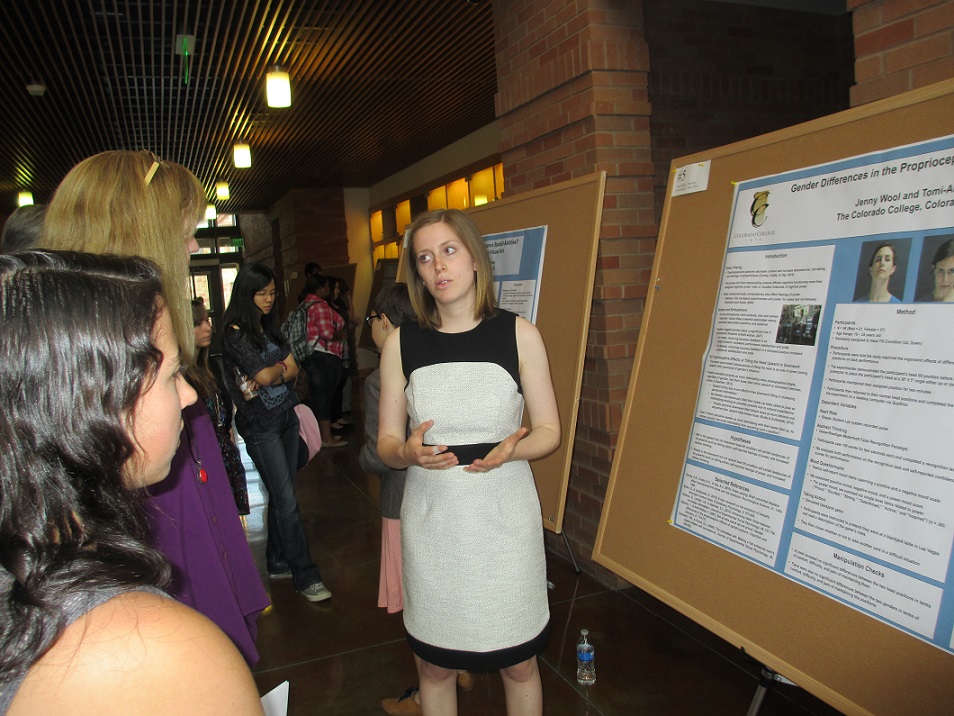
Psychology
Advisor: Tomi-Ann Roberts
Gender Differences in the Proprioceptive Effects of Tilted Faces
This study tested whether gender influenced the "power posing" effects of tilting the head upward (presumably embodying greater power) or downward (presumably a more submissive pose). Participants posed in either an upward or downward head tilt position before completing an abstract thinking task, a mood questionnaire, and a simulated blackjack game to measure taking action. In support of the hypothesis, results showed men in the upward condition were more confident than men in the downward condition as measured by a memory task, whereas women showed the opposite pattern. Contrary to the hypothesis, results showed men in the downward condition felt more positive, powerful, proud, inspired, and active than men in the upward condition, while women showed the reverse pattern. Gender but not condition affected taking action. The mixed results of this study suggest problems with the typical measures used to assess power, and also point to the need for more ecologically valid explorations of gender and power posing.
show all / hide all


